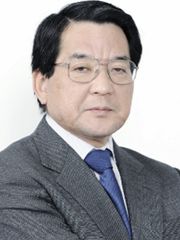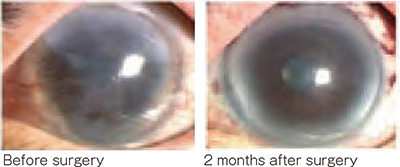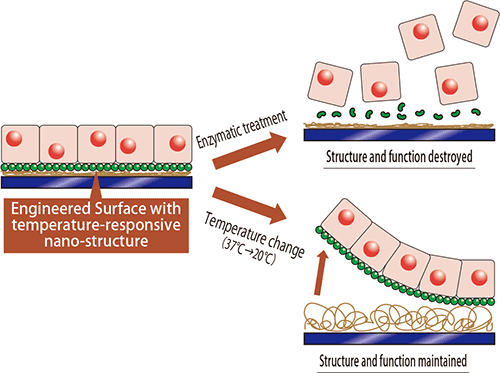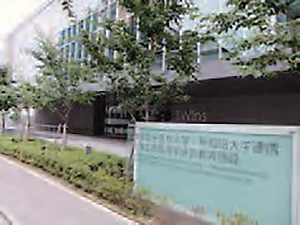Research Results
Just sticking the sheet can be a cure!
Miraculous Cell Sheet FY2017

- Teruo Okano (Professor Emeritus/Project Professor at Institute of Advanced BioMedical Engineering and Science (ABMES), Tokyo Women's Medical University)
- CREST
- Creation of Bio-Devices and Bio-Systems with Chemical and Biological Molecules for Medical Use
"Development of a Novel Tissue Reconstruction Technique and Next Generation Biosensors" Research Director (2001-2006) - FIRST
- "System Integration for Industrialization of Regenerative Medicine: Creation of Organ Factory" Core Researcher (2009-2013)
Creation of Innovation Centers for Advanced Interdisciplinary Research Areas Program
"Advanced Interdisciplinary Center for the Establishment of Regenerative Medicine" Researcher (Representative) (2006-2015)
Technology described as a "treasure of humanity"
When human organs lose their function, it is difficult for them to recover on their own. Although the advent of organ transplantation has brought about the greatest progress in modern medicine, saving many lives, this procedure still faces some severe limitations. The need for more donors, and the collateral problems caused after transplantation, together with the ethical concerns encourage the search for new alternatives. If we could create artificial organs, many more patients could be saved. Prof. Teruo Okano has established a technology for the manufacture of cell sheets to produce artificial organs: a long-held dream of humanity.
These cell sheets represent a foundational technology that can be applied to the regenerative therapies of various tissues and organs. For example, a clinical trial using myoblast cell sheets to treat heart failure has recently been completed. This success has allowed the release of the myoblast sheet as the world's first marketed product of engineered tissue for heart failure treatment. In addition, other clinical studies and trials for the treatment of esophagus, inner ear, articular cartilage, periodontal membrane, and cornea are actually being conducted both in Japan and abroad. Even when only considering the treatment of patients suffering from ischemic cardiac diseases (i.e. infarction), we could save several millions of patients worldwide by using cell sheet technology.
Schematic illustration of corneal epithelial cell sheet transplantation

The miracle sheet: just stick it on the injured area!
The cell sheet technology possesses many marvelous advantages, but the most remarkable is the simplicity of manipulation and transplantation. This is a crucial aspect that improves the success of surgical procedures. Essentially, the sheets can be stuck directly to the injured area, avoiding any additional suturing, and reducing the difficulties for both doctor and patient. For example, in the case of the corneal treatment, the procedure just requires placing the sheet lightly in position onto the eyeball. Furthermore, severe cardiac infarctions, which previously could only be cured by heart transplantation, can be treated by just sticking the cell sheets on the necrotic area. In this sense, the cell sheet transplantation is an amazing therapy that is beyond our traditional knowledge.
Another important benefit of the cell sheet therapy is that it allows the use of autologous cells, avoiding immunological rejection. In addition, there is no need for allogeneic donors, so the patients can be treated immediately.
Transplantation of autologous oral mucosal cell sheet to treat ocular pemphigoid

Development of culture dishes to create cell sheets
The important point in creating cell sheets is, in fact, the development of culture dishes. Although the adhesiveness of the cell sheets is an advantage for transplantation, it also makes it very difficult to detach the cell sheets from culture dishes. Conventionally, cultured cells are harvested from culture dishes by enzymatic digestion to destroy cell-dish connections. However, this method can damage the cells.
Accordingly, Prof. Okano developed novel culture dishes that allow detachment of cultured cells by temperature change, without destroying the cell membrane structure. The surfaces of these novel culture dishes are coated with a 20-nanometer-thick layer of temperature-responsive polymer, which changes its molecular structure depending on the temperature. The properties of this surface for cell attachment are similar to a normal culture surface at human body temperature around 37C, which is the standard temperature for cell culture. However, when the temperature decreases to 20C, the surface properties change to prevent cell attachment, allowing the cell sheet to detach from this surface without any damage. The development of this special culture dishes allowed the creation of cell sheets and their clinical applications.

New world achieved by integration of medicine, science, and engineering
The advances in modern medical treatment are not anymore relying solely on medical knowledge, but requiring close collaboration of medicine, science, and engineering. Actually, the development of the above- mentioned culture dishes could not be achieved by medicine alone. Prof. Okano firmly believes that new technologies developed through the fusion of medicine, science, and engineering will make it possible to save many patients regardless of the surgeon's skills. At the moment, some of these patients can be saved only by a handful of extremely prominent surgeons.
Following these beliefs and concepts, Tokyo Women' s Medical University and Waseda University have cooperated and established a joint institution for the research and education of advanced biomedical engineering and science. This multidisciplinary institution accomplished the fusion of medicine, science, and engineering, where clinicians, chemists, biologists, and engineers are working together, creating a research environment that is unique and unparalleled in the world.

